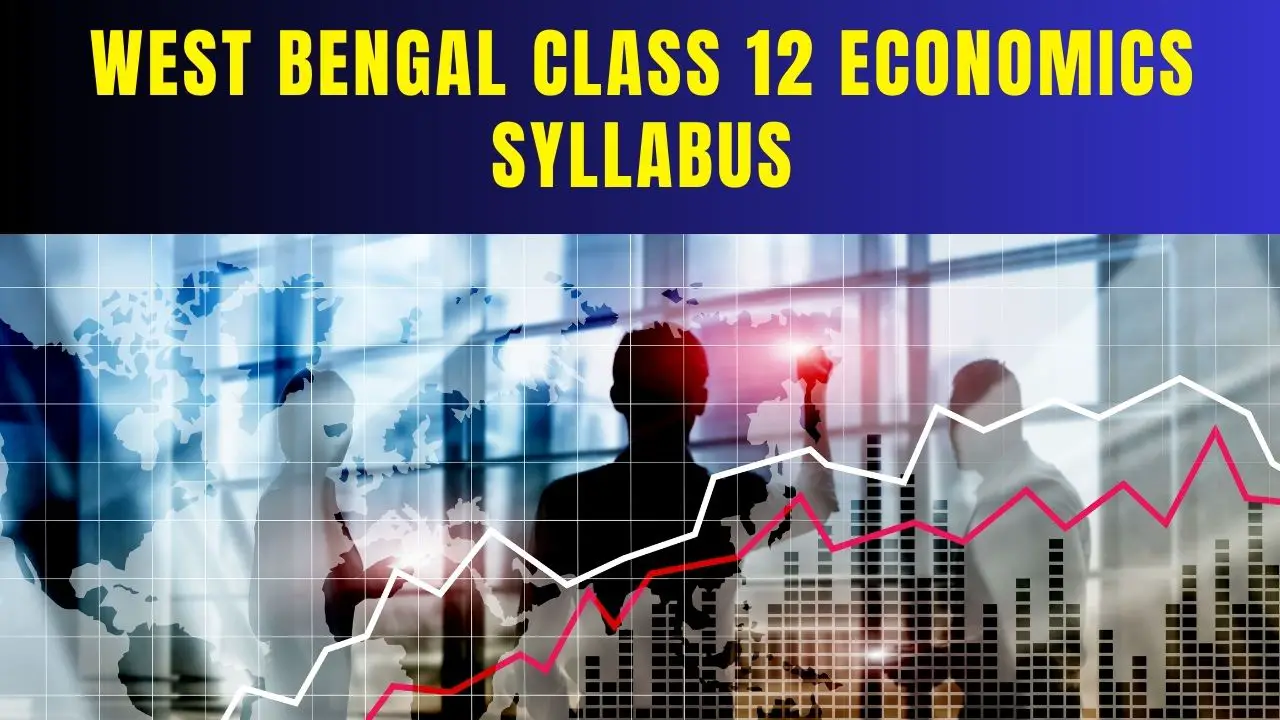West Bengal Class 12 Economics Syllabus: The West Bengal Council of Higher Secondary Education has recently unveiled the much-awaited WB 12th syllabus for the academic year 2023-24. Aspiring students gearing up for the West Bengal higher secondary exams in 2024 can access the comprehensive syllabus on the official website, wbchse.nic.in.
This syllabus encompasses a detailed breakdown of the topics to be studied for various subjects. Familiarizing oneself with the WB HS exam syllabus 2024 is crucial for students as it will play a vital role in achieving good scores in the West Bengal 12th exam. Additionally, the marking scheme provided in the syllabus will aid students in identifying the essential areas to focus on.
It is advisable for students to thoroughly grasp the WBCHSE syllabus 2023-24 well in advance of the commencement of the WB HS board examination in 2024. For further insight, the website offers stream-wise WB 12th syllabus 2023-24, covering all major subjects.
West Bengal Class 12 Economics Syllabus
The Economics syllabus for Class XII is designed to be a comprehensive course with a total of 100 marks. The syllabus is divided into three main components: Group A, Group B, and the Project, carrying 50, 30, and 20 marks, respectively. Group A covers essential topics in Economics, encompassing key concepts and theories that are fundamental for students’ understanding of the subject.
Group B delves deeper into specific areas of Economics, allowing students to explore and specialize in particular aspects of the discipline. The Project segment provides an opportunity for students to engage in independent research and analysis, enhancing their critical thinking and presentation skills. Through this well-structured syllabus, Class XII students will gain a comprehensive understanding of Economics and develop the necessary skills to excel in their academic pursuits and beyond.
Must Read: Quality Council of India (QCI) Recruitment 2023: How To Apply, Selection Process & More!
MICROECONOMICS -West Bengal Class 12 Economics Syllabus
Chapter 1 to 4
The Microeconomicssyllabus covers an extensive range of topics in Chapters 1 to 4.
- In Chapter 1, students will be introduced to the foundational concepts of Functions, Curves, Straight lines, and Slopes. Although this part is non-evaluative, it provides a crucial basis for understanding the subsequent chapters.
- Chapter 2 delves into the intricacies of Demand, exploring the factors that determine it, Demand Function, and Demand Schedule. The Law of Demand is thoroughly examined, along with individual and market demand, represented through Demand Curves. Moreover, students will learn about changes in demand and quantity demanded, and the concepts of Utility and Marginal Utility, including the Law of Diminishing Marginal Utility. The chapter also explores the Income and Substitution Effects and exceptions to the Law of Demand like Inferior Goods and Giffen Goods, as well as the concept of Consumer Surplus.
- Moving on to Chapter 3, the focus shifts to Elasticity, its types such as Price, Income, and Cross Elasticity, and factors influencing it. Students will also learn about various methods for measuring Elasticity, including Arc, Point, Unitary, Elastic, Inelastic, Perfectly Elastic, and Completely Inelastic Demand Curves, and the implications of Elasticity.
- Lastly, Chapter 4 delves into the Production Function, examining the Short Run and Long Run, the Law of Variable Proportions, and Returns to Scale. The shapes of Average Product, Total Product, and Marginal Product curves are studied, along with the relationships among them, providing students with a comprehensive understanding of production processes in economics.
Chapter 5 to 9
Chapters 5 to 9 of the Microeconomics syllabus offer a comprehensive exploration of various vital aspects of economic theory.
- Chapter 5 delves into the intricacies of Cost of Production, examining both Long Run and Short Run scenarios. Students will learn about Cost Curves, including their relationships with Average Cost (AC), Average Variable Cost (AVC), Marginal Cost (MC), Average Fixed Cost (AFC), Total Cost (TC), Total Variable Cost (TVC), and Total Fixed Cost (TFC). The interrelationship between Short Run Production and Short Run Cost is studied, along with the connection between short-run and long-run costs. Furthermore, the derivation of Long Run Cost Curves from Short Run Cost Curves is explained in detail.
- Moving on to Chapter 6, the focus shifts to Revenue, encompassing Total, Average, and Marginal Revenue, and the relationships among them. Students will also explore the connection between Average Revenue (AR), Marginal Revenue (MR), and Elasticity € of demand, examining Revenue under Variable Price and Fixed Price situations.
- In Chapter 7, students will dive into Profit Maximization and Producers’ Equilibrium, as well as the concept of the Shut Down Condition.
- Chapter 8 introduces the notion of Supply, studying Supply Function and its determinants, the Law of Supply, Individual Supply Curve, Market Supply Curve, and the Elasticity of Supply. Students will also learn about changes in supply and quantity supplied, along with the supply curve of an individual firm under Fixed Price Situations.
- Lastly, Chapter 9 provides an in-depth analysis of different types of markets, including Perfect Competition, Monopoly, Monopolistic Competition, Oligopoly, Duopoly, Price Discrimination, Bilateral Monopoly, and Monophony. This extensive exploration equips students with a comprehensive understanding of the various market structures and their implications on the economy.
Chapter 10 to 13
Chapters 10 to 13 of the Microeconomics syllabus delve into crucial economic concepts and market dynamics.
- In Chapter 10, students will explore Market Equilibrium under Perfect Competition. They will learn about the defining characteristics of Perfect Competition, where firms act as price takers and operate in a Fixed Price Situation. The chapter delves into the determination of prices, considering the interaction between Market Demand and Market Supply. Students will understand the equilibrium of a firm in the short run, the concept of the Shut Down Point, and the formation of Supply Curves for both individual firms and the entire industry. Additionally, the Long Run equilibrium and the idea of Normal Profit are thoroughly explained.
- Moving on to Chapter 11, students will study Equilibrium under Monopoly, examining the unique characteristics of monopolistic markets and how prices and outputs are determined in such a scenario.
- In Chapter 12, the focus shifts to Cost Determined Pricing, exploring concepts like Mark Up and Arbitrage, which play a significant role in pricing decisions.
- Lastly, Chapter 13 introduces students to the Factor Market, analyzing various factors of production such as Land, Labor, and Capital. Topics include Rent in the Land market, the Marginal Productivity Theory of Distribution for Labor, and the Liquidity Preference Theory of Interest for Capital. Through these chapters, students will gain a comprehensive understanding of market equilibriums, pricing mechanisms, and factors that shape the distribution of income in different economic scenarios.
MACROECONOMICS – West Bengal Class 12 Economics Syllabus
Chapter 14 to 16
Chapters 14 to 16 of the Macroeconomics syllabus encompass essential concepts in the study of the broader economic landscape.
- In Chapter 14, students will delve into the topic of National Income and Related Aggregates. They will learn about the Circular Flow of Income and how to calculate National Income through various methods, including the Value Added or Product Method, Expenditure Method, and Income Method.
- Chapter 15 focuses on the Determination of Income and Employment using the Keynesian Approach. Students will explore Aggregate Demand and its Components, Consumption, and the Consumption Function, as well as the Propensity to Consume and Save. The concept of Equilibrium Level of Income and the Investment Multiplier will be studied. Additionally, the chapter covers the idea of Full Employment, addressing issues like deficient demand, excess demand, inflation, demand-pull, and cost-push factors.
- Lastly, Chapter 16 introduces students to Money and Banking. They will learn about the Functions of Commercial Banks, including the creation of money, credit, and deposits. The concept of the Credit/Deposit/Money Multiplier is also explored. Furthermore, students will gain insight into the Functions of Central Banks and the various Tools and Methods of Credit Control used by them. These chapters provide students with a comprehensive understanding of national income measurement, income determination, and the crucial roles of money and banking in the overall functioning of an economy.
Chapter 17 and 18
Chapters 17 and 18 of the Macroeconomics syllabus cover significant aspects of fiscal policy and international trade.
- In Chapter 17, students will explore Fiscal Policy, an essential tool used by governments to influence the economy. They will learn about Expansionary Fiscal Policy, which involves increasing government expenditure to stimulate economic growth. The concept of the Government Expenditure Multiplier will be studied, along with Deficit Financing as a means to fund government expenditure. The chapter also addresses how Fiscal Policy can be employed to correct economic issues like recession and inflationary pressure. In times of recession, governments can use fiscal measures to boost economic activity, while during inflation, they can implement measures to curb excessive demand.
- Moving on to Chapter 18, students will dive into International Trade and the Balance of Payments (BOP). They will learn about the Balance of Trade, distinguishing between Surplus and Deficit scenarios, and the overall Balance of Payments, which includes the Current Account, Capital Account, and Unilateral Transfers. The chapter also addresses methods to correct imbalances in the BOP, which can impact a nation’s economy. Additionally, students will be introduced to the concept of Foreign Exchange Rates, including Flexible Exchange Rates, Floating Exchange Rates, and Managed Floating Exchange Rates, which play a crucial role in international trade and financial transactions. These chapters provide students with insights into the tools and mechanisms used by governments to stabilize their economies and manage international trade and financial flows effectively.
Must Read: WBPSC Clerkship Recruitment 2023: How To Apply, Selection Process & More!

